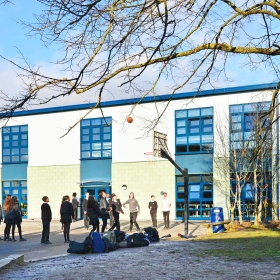Tarkett champions inclusive & equitable educational settings
In England, the number of pupils with special educational needs (SEN) has risen sharply to over 1.5 million, marking an increase of 87,000 new diagnoses since 2022. These figures, likely conservative due to assessment process timelines, show a consistent upward trend since 2016.
The importance of World Autism Awareness Day
April is especially important in our efforts to better understand neurodiversity, given the recognition of World Autism Awareness Day on the 2nd day of the month. This reminds us of the pressing need to improve the lives of those with Autism, ensuring they have the support to lead fulfilling and integrated lives within our communities every day of the year.
Sadly, today’s society isn’t built with neurodiversity in mind – particularly where the education system is concerned. Even though every class will have neurodiverse students, many of them can’t access sensory-friendly learning spaces, stripping them of the support, and future, they deserve. This is likely why only one in four Autistic children feel happy at school, while three in four parents or carers (74%) said their child’s school does not fully meet their needs.
However, there is hope. One of the UN’s 17 Sustainable Development Goals urges the world to build and upgrade inclusive and safe schools that are child, disability and gender sensitive, which is gradually encouraging the deep systemic change that our society needs to thrive. But, with an ever-challenging backdrop of finance and resource limitations, some people aren’t easily convinced.
Embracing inclusivity in design with Tarkett’s Human Conscious Design Principles
This is an issue that Tarkett, a people and planet-centric flooring provider, are continuously tackling, which spurred them to release their new Human Conscious Design Principles Guide. The guide provides specifiers and educators with a well-rounded understanding of how to better accommodate a much broader set of needs, specifically factoring in the traits typically presented by those with Autistic Spectrum Disorder (ASD) and/or with Attention Deficit Hyperactivity Disorder (ADHD).
Drawing on Tarkett’s own research into these conditions, while aligning with The Commission for the Architecture and Built Environment’s (CABE) inclusive design principles, the guide explores practical design considerations that can enhance learning environments. Given the spectrum of neurodiversity, it addresses both hyper-sensitivities (when a child feels sensory inputs intensely) and hypo-sensitivities (when the brain processes less sensory information) to create spaces that support self-regulation, preventing stress, overwhelm, and outbursts.
Tarkett’s research confirms this can be achieved through thoughtful space planning, along with careful material choices, which make environments fit for everyone, not just the majority.
The cruciality of conscious space planning
Conscious space planning is crucial, especially in busy environments like schools which can be a sensory nightmare for neurodiverse students. Tarkett suggests organising spaces according to their specific purposes (for example, separating work and play areas), through furniture arrangements, varied floor levels and ceiling heights, conscious colour-coding, and clear signage or visual aids to smooth transitions between areas.
For times when stimuli can’t be controlled, there should be designated safe spaces where neurodiverse students can retreat and self-regulate. This could be a calming environment with soft lighting and comfy seating for focus and relaxation, or dynamic setups with toys and tools to encourage movement and stimulation.
Utilising sensory-friendly materials in school design
A school’s choice of materials plays an equally vital role in creating sensory-friendly environments. Opting for softer flooring materials instead of tiles or resin surfaces helps minimise noise disruptions, while matt or low-sheen surfaces reduce glare, easing sensory processing. Equally, absorbent materials like carpeting dampen airborne noise in classrooms, aided further by noise-cancelling headphones which offer relief in areas where soft materials aren’t feasible, like canteens.
Colours, patterns, and textures should also be used carefully, considering that muted tones and simple patterns can help to prevent sensory overload, while the strategic use of bright colours can enhance creativity without overwhelming the senses.
Ultimately, it’s our collective responsibility to support individuals with Autism, ADHD, or any other neurodiversity, and Tarkett acknowledges that their Human Conscious Design Principles are just the beginning.
Download the guide here to find out how you can be part of the change:




Leave a Reply
Want to join the discussion?Feel free to contribute!